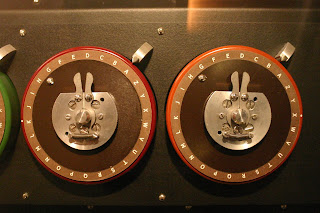As I intend to have my intonarumoris played with Saxophones, Drums, Electric Guitars and other sound making devices, I need to add amplification. While my larger intonarumori can just about hold its own in the noise making, the smaller intonarumoris need help, especially to bring out some of the quieter subtle tones.
Oh course I could just use a microphone on a stand to go through the PA, but by building the amplification into the intonarumori will give the user more control as to the sound.
My guide book for doing this is the excellent ' Handmade Electronic Music. The art of hardware hacking' by Nicolas Collins.
This book is wonderful manual of ideas. The second edition includes a DVD of 13 video tutorials. 'Its like me doing a workshop in your town' and 87 video clips and 20 audio tracks by over a 100 hackers, benders, musicians, artists and inventors from around the world'. Truly inspiring stuff. It's left me with a lot of ideas to further develop once I've finished my intonarumoris.
Two low cost methods to amplify are by using Piezo disks and/or electret microphone elements. Piezos are the most simple to use as a contact microphone picking up mechanical vibration, so depending where it is positioned in or on the intonarumori it will pick up a variety of sounds such as the lever and slider. Which may or may not be desirable. In contrast the electret microphone is more selective functioning as a conventional microphone.
 |
| Piezos of various sizes including one wired up about to be 'Plastic dipped'. |
Cost wise Piezos can be bought on ebay for as little as 6p!!! you will need to add on the cost of cable and jack socket. Electret microphones can cost about 37p but here you will need to add a circuit with a capacitor, resistor, switch and a 9 volt battery to power but still the cost will be under a pound! So a little bit of circuitry making here whereas the piezos can be just attached or soldered to a jack or socket.
 |
| Electret microphone |
 |
| Where would we be without Altoid tins |
 |
| Electret wiring |
Nicolas Collins' book gives some very good tips on how to strengthen the Piezos including using the amazing 'Plastic Dip'! Where has this product been all my life! I did buy a contact mic for £3.50 which fell to bit on first use, revealing a piezo inside a plastic case, soldered badly! Making your own is a far better and stronger option. By cheaply manufacturing a number of Piezos these can be positioned in different locations about the intonarumori. Which can act as a sound filter and vary the mechanical vibrations being picked up.
 |
| Altoid tin with magnetic strip to position on the intonarumori horn |
|
| . |
|
Just a word about tools and equipment. This used to be how I went about my soldering. I always found it hard work.
 |
| old school | | | | | | |
|
| | | |
Here's my new equipment. I feel very guilty about having used the above kit in my lessons for over 20 years. Sorry kids.
 |
| New kit. |
I looked to buy the best possible equipment based on this guys recommendations.
https://youtu.be/J5Sb21qbpEQ
Careful here his language is sometimes er...colourful.























